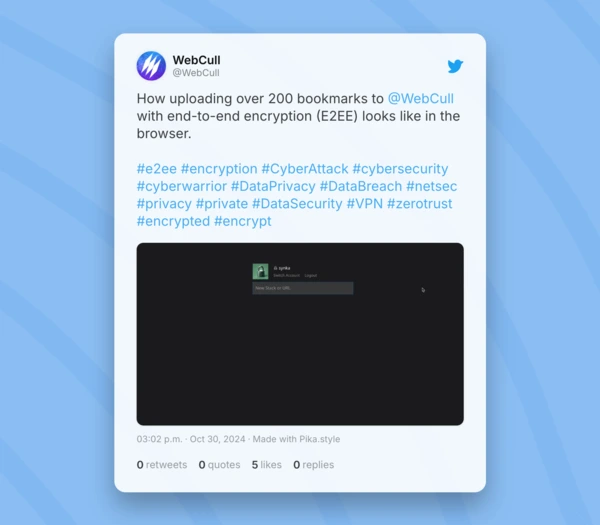The Evolution of Hyperlinks
Bookmarks have a long history, dating back to the early days of web browsing. The first web browser, WorldWideWeb, developed by Tim Berners-Lee in 1990, is the first web browser to introduce the concept of hyperlinks or what we just call 'links' nowadays. It was also capable of basic stylesheets, downloading files, images, and more, but it wasn't until the release of Mosaic in 1993 that the idea of a 'bookmark'—what you call a link when it's saved to your computer—became widely accessible. This innovation was pivotal in making the web user-friendly, allowing users to save and organize their website links.
Since the early days of the web links themselves have remained largely the same from a user's perspective. What has evolved dramatically are the features built around organizing and accessing bookmarks. Traditional browser bookmark managers have made incremental improvements, such as enhanced folder structuring, some have tagging and sorting options, and keyword-based search functionalities, but there remains much room for enhancement. Different browsers still lack cross-platform support, and bookmark management is often fragmented across ecosystems. Services like WebCull are driving the future of bookmarking forward, focusing on critical improvements such as multi-browser synchronization, encrypted storage, collaborative sharing, and more sophisticated sorting and tagging options. These features aim to address the deficiencies in traditional bookmark systems and create a more cohesive and secure experience for users across all platforms.
The Iteration of Advancements
The convenience of bookmarking introduces new challenges. Many traditional bookmark managers rely on proprietary servers that exclusively support only their own browsers. This means that if you are using different browsers across multiple devices—such as Chrome on a laptop and Safari on an iPhone—your bookmarks won't sync seamlessly. This lack of cross-browser compatibility often necessitates using a third-party service like WebCull, which provides synchronization across any browser and device, making bookmark management consistent and accessible regardless of the ecosystem.
One of the most significant advancements of modern bookmark managers is their capability to synchronize content across all devices and browsers. Whether you are using a workstation at the office, a smartphone on the move, or a tablet at home, these services ensure that your meticulously curated links, organized folders, and stored resources are always within reach. There is no longer any need for manual backups or concerns about data consistency—everything remains continuously up-to-date. This convenience allows users to focus entirely on the content itself rather than the complexities of managing it. Imagine attending a crucial meeting and needing to reference a specific link; knowing that your bookmarks are accessible from anywhere gives you a sense of reassurance, supporting your efforts without the tech issues.
The Key to Privacy and Trust
With the emergence of sync systems, new privacy concerns have also come into the spotlight. Bookmarks can contain highly personal and identifiable information, especially when they are visible across all devices and platforms, making immediate encryption upon syncing crucial. This makes sync systems a potential privacy risk because if a sync server is compromised during a data breach, your sensitive information could be exposed and even sold on the dark web without your knowledge. Data breaches are an ongoing threat, occurring more frequently than ever, and the only effective safeguard against this vulnerability is through the implementation of end-to-end encryption (E2EE). E2EE ensures that only you have access to the encrypted data, even if the sync server itself is breached.
Almost all proprietary bookmark services, including some mainstream browsers, lack true end-to-end encryption capabilities. For instance, browsers that share similar foundations—such as Chromium-based Edge, fails to provide end-to-end encryption for bookmarks, despite their common underlying technologies. Some browsers don't directly claim to have end-to-end encryption by name and others we couldn't get working, but they all don't work together. This lack of consistent, reliable security across popular browsers leaves users exposed, particularly when dealing with sensitive or personal data.
While bookmarks generally are automatically encrypted during their journey (encryption in-transit), they are decrypted on the servers when they are received and stored, rendering them vulnerable to unauthorized access or data breaches. For users storing highly sensitive information—such as links to legal documents, medical records, or confidential research, and more—the potential exposure of such data is unacceptable. These types of documents are particularly valuable, and the very prospect of unauthorized exposure raises substantial privacy concerns for individuals and organizations that prioritize data security.
End-to-end encryption addresses these vulnerabilities by ensuring that bookmarks are encrypted from the moment they leave your device until the moment they are accessed again. With E2EE, even the service provider has no capability to decrypt the data, as only your device retains the necessary cryptographic keys. Consequently, your private and sensitive information remains exclusively yours, safeguarded from unauthorized surveillance and access. This encryption protocol aligns with rigorous privacy regulations, such as the General Data Protection Regulation (GDPR) and the California Consumer Privacy Act (CCPA), ensuring the confidentiality and protection of your data. Privacy compliance is far from being a superficial concept; it is an imperative necessity, and E2EE allows users to maintain compliance while preserving usability.
Effective end-to-end encryption depends on advanced technologies and the implementation of high-quality encryption algorithms. The use of well-established algorithms like Advanced Encryption Standard in Galois/Counter Mode (AES-256-GCM) is common, but the key is ensuring that the encryption remains state-of-the-art and is upgraded as needed to stay ahead of emerging threats. E2EE must rely on secure cryptographic keys that never leave the user's device, making the data truly private. In this approach, even if servers are compromised, user data remains inaccessible. It is equally crucial for services to be transparent about the encryption methods they use, ensuring users are aware of the types of protection they are receiving. This not only strengthens trust but also educates users on how their sensitive information is being safeguarded. Services like WebCull excel by not just applying robust encryption, but also by communicating clearly how it works, making the privacy protections understandable and accessible.
The Future of Online Bookmarks
WebCull further distinguishes itself by incorporating features that enhance productivity beyond just security and accessibility. Users can search for bookmarks using relevant keywords, organize them into easily navigable stacks or folders, and even share curated collections when necessary—all while having access to their bookmarks in any browser. This makes WebCull not merely a storage solution, but a sophisticated tool for boosting productivity and work efficiency.
There is an increasing demand for solutions that are both efficient and privacy-oriented when accessing web tools and resources. Imagine a future where all your tasks are handled solely through web-based tools and services—this vision is quickly becoming a reality for many users today. The integration of end-to-end encryption (E2EE) into these services provides a much-needed layer of confidence, ensuring that privacy is never compromised while blending the best aspects of convenience and security. As cloud solutions evolve, the workspace is moving towards a model where privacy, efficiency, accessibility, capabilities, and reliability are prioritized, empowering users to trust and rely on the technology they use.
We anticipate that more bookmark managers and similar online tools will adopt E2EE as a default standard in the coming years. Users are rightly demanding greater transparency and control over their personal data. By incorporating E2EE, companies like WebCull are helping pave the way toward a more secure internet—one in which users retain authority over their own information. Ultimately, this shift is not solely about privacy; it is about empowerment. Providing individuals with the freedom to store and manage digital content in the cloud, all without fear of unauthorized access, is integral to fostering a better online experience. Through the adoption of E2EE services, bookmark management transcends simple convenience, evolving into a service defined by trust, reliability, and long-term security.

